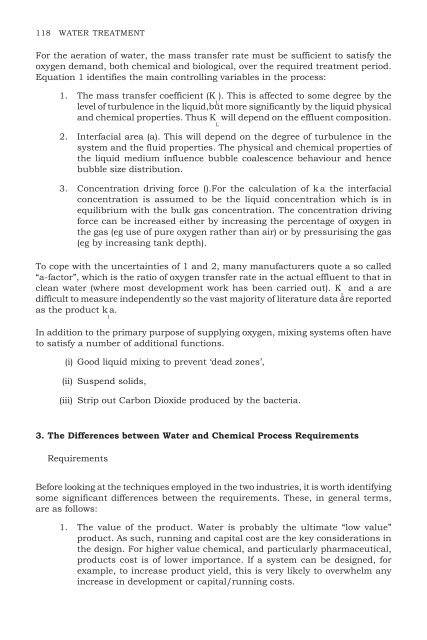Advances in Water Treatment and Enviromental Management
Advances in Water Treatment and Enviromental Management
Advances in Water Treatment and Enviromental Management
Create successful ePaper yourself
Turn your PDF publications into a flip-book with our unique Google optimized e-Paper software.
118 WATER TREATMENTFor the aeration of water, the mass transfer rate must be sufficient to satisfy theoxygen dem<strong>and</strong>, both chemical <strong>and</strong> biological, over the required treatment period.Equation 1 identifies the ma<strong>in</strong> controll<strong>in</strong>g variables <strong>in</strong> the process:1. The mass transfer coefficient (K ). This is affected to some degree by theLlevel of turbulence <strong>in</strong> the liquid,but more significantly by the liquid physical<strong>and</strong> chemical properties. Thus K will depend on the effluent composition.L2. Interfacial area (a). This will depend on the degree of turbulence <strong>in</strong> thesystem <strong>and</strong> the fluid properties. The physical <strong>and</strong> chemical properties ofthe liquid medium <strong>in</strong>fluence bubble coalescence behaviour <strong>and</strong> hencebubble size distribution.3. Concentration driv<strong>in</strong>g force ().For the calculation of k a the <strong>in</strong>terfaciallconcentration is assumed to be the liquid concentration which is <strong>in</strong>equilibrium with the bulk gas concentration. The concentration driv<strong>in</strong>gforce can be <strong>in</strong>creased either by <strong>in</strong>creas<strong>in</strong>g the percentage of oxygen <strong>in</strong>the gas (eg use of pure oxygen rather than air) or by pressuris<strong>in</strong>g the gas(eg by <strong>in</strong>creas<strong>in</strong>g tank depth).To cope with the uncerta<strong>in</strong>ties of 1 <strong>and</strong> 2, many manufacturers quote a so called“a-factor”, which is the ratio of oxygen transfer rate <strong>in</strong> the actual effluent to that <strong>in</strong>clean water (where most development work has been carried out). K <strong>and</strong> a areLdifficult to measure <strong>in</strong>dependently so the vast majority of literature data are reportedas the product k a.lIn addition to the primary purpose of supply<strong>in</strong>g oxygen, mix<strong>in</strong>g systems often haveto satisfy a number of additional functions.(i) Good liquid mix<strong>in</strong>g to prevent ‘dead zones’,(ii) Suspend solids,(iii) Strip out Carbon Dioxide produced by the bacteria.3. The Differences between <strong>Water</strong> <strong>and</strong> Chemical Process RequirementsRequirementsBefore look<strong>in</strong>g at the techniques employed <strong>in</strong> the two <strong>in</strong>dustries, it is worth identify<strong>in</strong>gsome significant differences between the requirements. These, <strong>in</strong> general terms,are as follows:1. The value of the product. <strong>Water</strong> is probably the ultimate “low value”product. As such, runn<strong>in</strong>g <strong>and</strong> capital cost are the key considerations <strong>in</strong>the design. For higher value chemical, <strong>and</strong> particularly pharmaceutical,products cost is of lower importance. If a system can be designed, forexample, to <strong>in</strong>crease product yield, this is very likely to overwhelm any<strong>in</strong>crease <strong>in</strong> development or capital/runn<strong>in</strong>g costs.
















